Lunging with Decarpentry
Lunging with Decarpentry.
Jean Luc Cornille

Chazot
In his Academic Equitation, General Decarpentry refers to three lunging techniques that he presents as first (I), second (II) and third (III)
manner. The technique applied here is the second manner. 
A ring is attached on the sursingle or the saddle. As the horse is turning to on a left circle, the lunge line goes through the left side of the bit, up through the ring in front of the saddle and is attached on the right side of the bit. Through experience, I have found that the first manner was shortening the horses’ neck and the third solution was rarely useful.
The purpose here is not to promote lunging but rather present a technique minimizing the damages caused by long lunging sessions, (see “The Side Effects of Lunging). The stresses induced on the limbs joints and vertebral column structures are related to the inclination of the horse’s body at the end of the lunge line. The average angle is 67º and the body inclination increases in relation to the speed. The two elements that are minimizing the side effects of lunging are for one, adding as many straight lines as possible and for two, maintaining the horse at his natural cadence. Cues and voice commands are useful as long as they are reduced to the minimum.
that are minimizing the side effects of lunging are for one, adding as many straight lines as possible and for two, maintaining the horse at his natural cadence. Cues and voice commands are useful as long as they are reduced to the minimum.
In some instances more control is necessary and the Decarpentry’s approach does give such control without imposing any neck posture. Beside morphological differences, there are also variations in the type of muscles horses have in their neck and entire body. Some variations are from genetics, others are from training. The bottom line is that if it is true that a horse will naturally enhances proper functioning of his vertebral column adopting a longer neck posture, it is erroneous to think that imposing a given neck posture will ensure proper mechanism of the horse’s vertebral column.
Speed is created stiffening the back muscles and as soon as the horse is rushed faster than his natural cadence, vertebral column rigidity occurs. At the walk, the hind and front legs are acting as levers. At the trot, hind and front limbs are acting as spring. The canter involves a combination of both, lever and spring action. At the walk, the horse’s natural cadence is the cadence where the legs movements are perfectly synchronized with lateral and transversal motions of the horse’s vertebral column. At the trot, the natural cadence is the cadence where the hind and front limbs are coordinating their propulsive activity lifting simultaneously the croup and the shoulders. The natural cadence at the trot is springy and rhythmical. An observation made in 1993 helps to visualize the horse’s natural cadence. “In horses, and most other mammalian quadrupeds, 57% of the vertical impulse is applied through the thoracic limbs, and only 43% through the hind limbs.” (H. W. Merkens, H. C. Schamhardt,G. J. van Osch, A. J. van den Bogert, 1993). At the canter the natural cadence gives the impression of suppleness, rhythm and balance control.
Decarpentry’s technique works well if the horse has been trained to give a very light contact on the bit. By contrast, the technique may rapidly over-bend the horse’s neck if the horse is leaning heavily on the bit or the trainer is maintaining a strong contact on the lunge line.
Jean Luc Cornille





